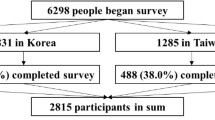Abstract
Sexual harassment in public places is a forbidden form of sex discrimination that includes both verbal and nonverbal behaviors—such as wolf whistles, leers, winks, grabs, pinches, catcalls, and street remarks—and is often overlooked by social science researchers. The present study, using mixed methods and “exploratory design-instrument development method” was conducted to investigate the aspects of Iranian women’s experiences of sexual harassment in public places using a student sample. Using the grounded theory method, the qualitative part of this study was conducted by face-to-face, in-depth interviews with 16 female students of Shiraz University, Shiraz, Iran, which resulted in seven axial categories and one core category. The results of the qualitative part of the study were used to develop the instrument of the quantitative part, the questionnaire. Using the survey technique, the quantitative phase of this study employed a sample of 369 female students of Shiraz University, selected by stratified sampling. Data analysis procedures included a theme analysis of the interviews, a statistical analysis of the survey, and an integrated consideration of the qualitative and quantitative results. We found that experiencing sexual harassment is significantly correlated with presence in public places, acceptance of gender rules, mother’s education and the kind of women’s dressing and make up.

Similar content being viewed by others
Notes
-
A long scarf that some Muslim women wear in public, which covers their entire body.
-
Having a boyfriend is often considered to be negative for women in Iranian culture.
References
Bartky, S. (1988). Foucault, feminity and the modernization of patriarchal power. In I. Diamond (Ed.), Feminism and Foucault: Reflections on resistance. Boston: Northeastern University Press.
Bowman, C. G. (1993). Street harassment and the informal ghettoization of women. Harvard Law Review, 106(3), 517–580.
Burgess, D., & Borgida, E. (1999). Who women are, who women should be: Descriptive and prescriptive gender stereotyping in sex discrimination. Psychology, Public, Policy and Law, 5(3), 665–692.
Cameron, D. (1995). Verbal hygiene. London: Routledge.
Cohen, L., Manion, L., & Morrison, K. (2000). Research methods in education (5th ed.). London: RoutledgeFalmer.
Creswell, J. W. (2003). Research design: Qualitative, quantitative and mixed methods approaches. Thousand Oaks, CA: Sage.
Creswell, J. W. (2007). Designing and conducting mixed methods research. Thousand Oaks, CA: Sage.
Crosby, F. J., Stockdale, M. S., & Ropp, S. A. (2007). Sex discrimination in the workplace. Oxford: Blackwell.
Doyle, J. A., & Paludi, M. A. (1998). Sex and gender. The human experience. Boston: McGraw-Hill.
Drew, P. E., Francoeur, R. T., & Sadeghpour, F. A. (2004). International encyclopedia of sexuality. Iran. http://www.kinseyinstitute.org/ccies/ir.php.
Fairchild, K. M. (2007). Everyday stranger harassment: Frequency and consequences. A Dissertation for the Degree of Doctor of Philosophy, New Brunswick University of New Jersey.
Fairchild, K. M., & Rudman, L. A. (2008). Everyday stranger harassment and women’s objectification. Social Justice Research, 21(3), 338–357.
Gardner, C. B. (1995). Passing by: Gender and public harassment. Berkley, CA: University of California Press.
Garousi, S. (2005). The study of effect of stereotypes on gender inequality. Case study: Kerman and villages. A Dissertation for the Degree of Doctor of Philosophy, Iran, Shiraz University.
Goffman, E. (1963). Behavior in public places: Notes on the social organization of gatherings. New York: Free Press.
Goffman, E. (1971). Relations in public: Microstudies of the public order. New York: Basic Books.
Leech, N. L., & Onwuegbuzie, A. J. (2009). A typology of mixed methods research designs. Quality and Quantity, 43(2), 265–275.
Lenton, R., Smith, M. D., Fox, J., & Morra, N. (1999). Sexual harassment in public places: Experiences of Canadian women. Canadian Review of Sociology, 36(4), 517–540.
Leyens, J.-P., Yzerbyt, V. Y. A., & Schadron, G. (1994). Stereotypes and social cognition. London: Sage.
Lynn Lord, T. (2009). The relationship of gender-based public harassment to body image, self-esteem, and avoidance behavior. A Dissertation for the Degree of Doctor of Psychology, Indiana University of Pennsylvania.
MacMillan, R., Nierobisz, A., & Welsh, S. (2000). Experiencing the streets: Harassment and perceptions of safety among women. Journal of Research in Crime and Delinquency, 37, 306–322.
Menon, S., & Kanekar, S. (1992). Attitudes toward sexual harassment of women in India. Journal of Applied Social Psychology, 22, 1940–1952.
Parish, W. L., Das, A., & Laumann, E. O. (2006). Sexual harassment of women in urban China. Archive of Sexual Behavior, 35, 411–425.
Patton, M. Q. (1987). How to use qualitative methods in evaluation. London: Sage.
Pina, A., Gannon, T. A., & Saunders, B. (2009). An overview of the literature on sexual harassment: Perpetrator, theory, and treatment issues. Aggression and Violent Behavior, 14, 126–138.
Sigal, J., & Jacobsen, H. (1999). A cross-cultural exploration of factors affecting reactions to sexual harassment: Attitudes and policies. Psychology, Public Policy, and Law, 5(3), 760–785.
Teddlie, C., & Tashakkori, A. (2003). Major issues and controversies in the use of mixed methods in the social and behavioral sciences. In A. Tashakkori & C. Teddlie (Eds.), Handbook of mixed methods in social and behavioral research (pp. 3–50). Thousand Oaks, CA: Sage.
Wesely, P. M. (2010). Language learning motivation in early adolescents: Using mixed methods research to explore contradiction. Journal of Mixed Methods Research, 4(4), 295–312.
Author information
Authors and Affiliations
Corresponding author
Rights and permissions
About this article
Cite this article
Lahsaeizadeh, A., Yousefinejad, E. Social Aspects of Women’s Experiences of Sexual Harassment in Public Places in Iran. Sexuality & Culture 16, 17–37 (2012). https://doi.org/10.1007/s12119-011-9097-y
Published:
Issue Date:
DOI: https://doi.org/10.1007/s12119-011-9097-y



